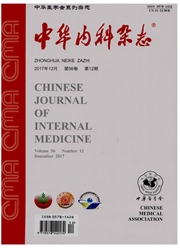

 中文摘要:
中文摘要:
目的探讨中国人不同部位黏膜相关淋巴组织结外边缘区淋巴瘤(MALTL)中分子遗传学异常的发生情况。方法应用间期荧光原位杂交(FISH)方法,检测217例不同部位MALTL的t(11;18)(q21;q21)/AP12-MALT1、t(1;14)(p22;q32)/IGH—BCL10、t(14;18)(q32;q21)/IGH—MALT1和涉及BCL6基因的染色体易位。结果染色体易位的总发生率为21%(46/217)。全部病例共检测出4种主要染色体异常,其中第1种13%(29/217)为t(11;18)(q21;q21)/AP12-MALT1,最常见的发生部位是肺47%(8/17)和小肠29%(4/14),其次为唾液腺1/6例、胃14%(12/84)和眼附属器6%(4/68)。第2种1%(3/217)为t(1;14)(p22;q32)/IGH-BCL10,仅见于肺12%(2/17)和胃1%(1/84)。第3种1%(2/217)为t(14;18)(q32;q21)/IGH-MALT1,仅见于肺6%(1/17)和眼附属器2%(1/68)。第4种2%(4/217)为BCL6基因涉及的染色体易位,见于唾液腺1/6例和胃4%(3/84)。4%(8/217)为涉及IGH基因但未知与其易位的伙伴基因的染色体易位。结论以上4种染色体易位在中国人不同解剖部位的MALTL中的发生率有明显不同,与欧美国家所报道的染色体易位的发生率相比较,分布稍有差异。
 英文摘要:
英文摘要:
Objective To investigate the genetic aberrations in extranodal marginal zone lymphoma of mucosa-assoeiated lymphoid tissue (MALT) lymphomas from different sites of the body in Chinese patients. Methods Two hundred and seventeen paraffin-embedded MALT lymphoma specimens from 11 major sites were studied with interphase fluorescence in situ hybridization (FISH) to detect t( 11 ; 18 ) ( q21 ; q21 )/API2-MALTI, t( 1 ; 14 ) ( p22 ;q32 )/IGH-BCL10, ( 14; 18 ) ( q32 ; q21 )/IGH-MALT1 and BCL6 gene involved chromosome translocations. Results These translocations were mutually exclusive and detected in 21% (46/217) of the cases, including t ( 11 ; 18) ( q21 ; q21 ) API2-MALT1 13% (29/217), t ( 1 ; 14) (p22;q32)IGH-BCL10 in 1% (3/217), t(14;18)(q32;q21)IGH-MALT1 1% (2/217), BCL6 involved translocation in 2% (4/217) and IGH-unknown translocation partner in 4% ( 8/217 ). t ( 11 ; 18 ) ( q21 ; q21 )API2-MALT1 was found with the highest frequency in MALT lymphoma from lungs (47%, 8/17 ) and small intestine (29%, 4/14), followed by salivary gland (17%, 1/6), stomach (14%, 12/84) and ocular adnexae (6%, 4/68). t(1 ;14)(p22 ;q32) was only detected in lungs (12%, 2/17) and stomach ( 1% , 1/84). t ( 14 ; 18 ) ( q32 ; q21 ) was mainly detected in lungs (6% , 1/17 ) and ocular adnexae (2 % , 1/68). BCL6 gene involved translocation was detected in salivary gland (17% , 1/6) and stomach (4% , 3/84). Conclusions It is demonstrated that the four translocations occur with markedly variable frequencies in MALT lymphoma of different sites in Chinese patients. The distributions of these chromosome translocations in Chinese patients are slightly different from those reported in western patients.
 同期刊论文项目
同期刊论文项目
 同项目期刊论文
同项目期刊论文
 期刊信息
期刊信息
